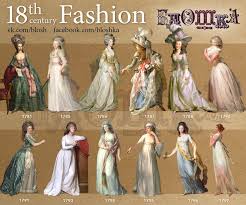The Elegance of 18th Century Clothing
During the 18th century, clothing was not just a necessity but a symbol of social status, wealth, and fashion. The fashion trends of this era were influenced by various factors such as royalty, culture, and trade.
For men, the typical attire consisted of knee-length breeches, waistcoats, coats with long tails, stockings, and buckled shoes. Wigs were also commonly worn to signify wealth and status. Fabrics like silk, velvet, and brocade were popular choices for formal occasions.
Women’s fashion in the 18th century was characterized by elaborate dresses with wide skirts, fitted bodices, and intricate embroidery. Pastel colours and floral patterns were fashionable choices for everyday wear. Accessories such as gloves, fans, and elaborate hats completed the ensemble.
One iconic garment that emerged during this period was the mantua dress for women. This gown featured a fitted bodice with a flowing skirt that was often worn over a petticoat. The mantua dress symbolised elegance and femininity.
Throughout the century, fashion evolved with changes in society and culture. The latter part of the 18th century saw the rise of neoclassical influences in clothing design inspired by ancient Greek and Roman styles.
In conclusion, 18th century clothing reflected not only the fashion preferences of the time but also served as a form of expression and social distinction. The intricate designs, luxurious fabrics, and attention to detail showcased the elegance and sophistication of this remarkable era in fashion history.
Frequently Asked Questions About 18th Century Clothing Styles
- What was 18th century men’s clothing called?
- What kind of clothing did they wear in the 1800’s?
- What did they wear in the 18th century?
- How to dress like an 18th century woman?
What was 18th century men’s clothing called?
During the 18th century, men’s clothing was commonly referred to as “breeches” or “breeches suits.” These outfits typically consisted of knee-length breeches, waistcoats, coats with long tails, stockings, and buckled shoes. The attire was a symbol of status and fashion during this era, with fabrics like silk, velvet, and brocade being popular choices for formal occasions. Additionally, wigs were often worn to further signify wealth and social standing. The attention to detail and elegance of 18th century men’s clothing reflected the societal norms and fashion trends of the time.
What kind of clothing did they wear in the 1800’s?
In the 1800s, fashion underwent significant transformations, reflecting the changing societal norms and cultural influences of the time. Clothing styles varied throughout the century, with distinct trends emerging in different decades. At the beginning of the 19th century, men typically wore tailcoats, waistcoats, and breeches, while women favoured high-waisted dresses with empire silhouettes. As the century progressed, men’s fashion evolved to include frock coats and trousers, while women’s attire featured fuller skirts and corseted bodices. Fabrics such as silk, cotton, and wool were commonly used in clothing production. The 1800s witnessed a fusion of traditional styles with innovative designs, resulting in a diverse range of clothing choices that reflected the dynamic spirit of the era.
What did they wear in the 18th century?
In the 18th century, both men and women wore clothing that reflected the prevailing fashion trends of the time. Men typically donned knee-length breeches, waistcoats, coats with long tails, stockings, and buckled shoes, often accompanied by wigs to denote their social status. Women’s attire featured elaborate dresses with wide skirts, fitted bodices, and intricate embroidery, complemented by accessories like gloves and fans. Fabrics such as silk, velvet, and brocade were favoured for formal occasions. The clothing of the 18th century not only served a practical purpose but also conveyed wealth, style, and societal standing through its design and materials.
How to dress like an 18th century woman?
To dress like an 18th century woman, start by selecting a gown with a fitted bodice and a full skirt, typical of the era. Opt for pastel colours and floral patterns for a classic look. Pair the gown with a petticoat to achieve the desired silhouette. Accessorise with gloves, a fan, and an elaborate hat to complete the ensemble. Consider adding lace or embroidery for an extra touch of elegance. Don’t forget to style your hair in a period-appropriate manner, such as wearing it up in curls or adorned with ribbons and flowers. Embracing the fashion of the 18th century allows you to step back in time and embody the grace and sophistication of women from that era.

